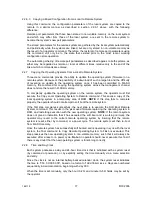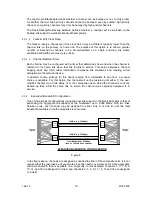
166119
8/31/2006
8
F
20 - (320) bits
Da
1
Da
2
Da
3
Da
4
Da
5
Da
6
M
1
M
2
M
3
F
Da
1
Da
2
Da
3
Da
4
Da
5
Da
6
M
1
M
2
M
3
Db
1
Db
2
Db
3
Db
4
Db
5
Db
6
Da
5
1
2
3
4
5
6
7
8
9
10
11
12
13
14
15
16
17
18
19
20
Channel "a"
allocated = 2400Bps
Channel "b"
allocated = 2400Bps
. . .
F - Framing timeslot
M - Management channel timeslot
Da, Db - Data channel a or b timeslot
Figure 4 – Frame and Super-frame Multiplexing
2.1.2 Demultiplexer
Demultiplexing of the composite data stream is accomplished using the same timeslot
channel mapping as used for multiplexing. One difference is that the demultiplexer must first
locate the super-frame bit pattern in the data stream as a reference point for all other
timeslots that follow. Once the repetitive super-frame bit pattern has been recognized and
located, the demultiplexer is said to be in “synchronization” with the remote multiplexer.
Having located the super-frame bit pattern, the demultiplexer can send each arriving bit
following the framing bit to the specific channel port buffer to which it is assigned, including
the management channel.
2.1.3 FIFO Buffers
Timeslots comprising a single channel need not be evenly distributed throughout the frame
(and in fact, seldom are). For this reason, serial data bits associated with a given port are
often transmitted and received in patterns of bursts and lulls that is much different than the
fixed bit rate of the port.
While the average rate of channel bits on the composite link will always equal that at the port,
it is necessary to buffer a small number of bits for each channel between the port and the
composite link. These buffers, referred to as “FIFOs” (First-In, First-Out buffers) are memory
arrays used for the purpose of regulating the flow of data.
2.1.4 Channel Allocation / De-allocation
Channels are associated with a corresponding port number; thus Port 7 is tied to Channel 7,
for example. The user determines which ports to utilize, their interface speeds, and other
parameters associated with the port interface or the channel, and then goes about
configuring them.
Prior to the channel being allocated, the user is able to freely modify these parameters.
However, until the channel is allocated, no data can be exchanged between the two ports at
each end of the link. When the channel is allocated, the bandwidth and timeslots are
assigned and the port becomes active.
All of the channel and port parameters may be modified after a channel has been allocated.
In those cases where the channel bandwidth is altered, either by changing the channel rate
or modifying the transport of control status, the system will automatically de-allocate the
channel and then subsequently re-allocate the same channel with the new parameters. This
will result in a momentary interruption or loss of data while the process takes place, but
Содержание Nx8- Dual Composite MUX High-Speed 16-Port TDM Multiplexer
Страница 2: ......
Страница 6: ...166119 8 31 2006 2...
Страница 32: ...166119 8 31 2006 28...
Страница 38: ...166119 8 31 2006 34...
Страница 61: ...166119 8 31 2006 57...
Страница 62: ...166119 8 31 2006 58...












































